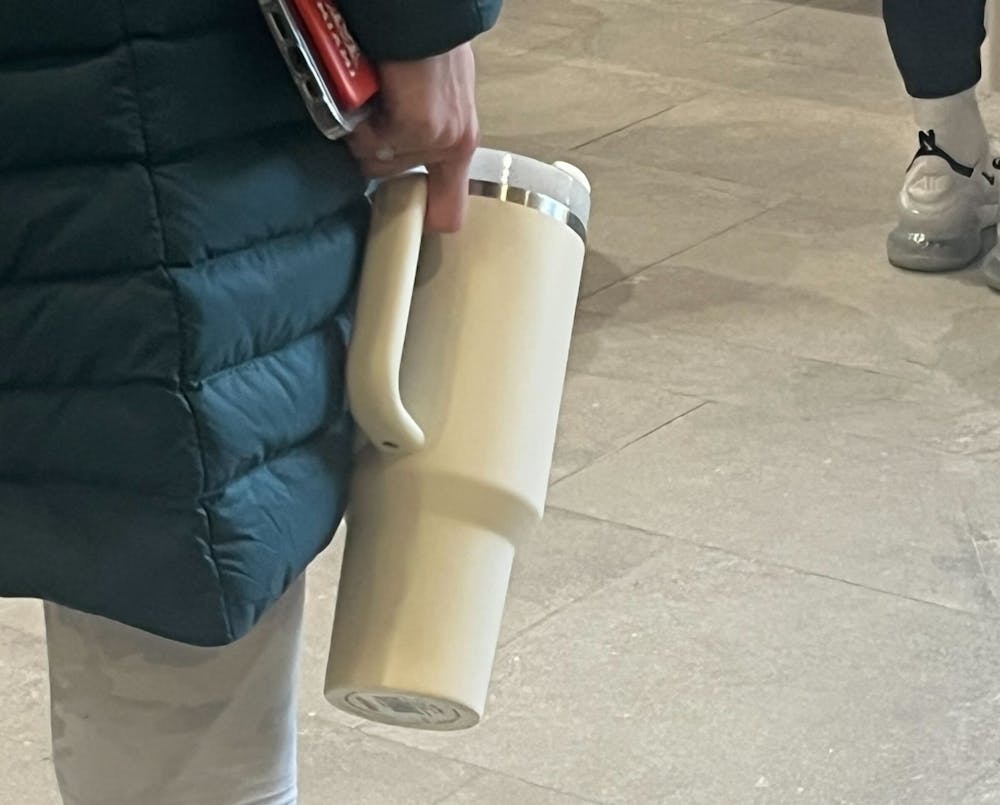If you’ve been seeing the Stanley Tumbler water bottle everywhere, you’re not alone, and you’re not seeing it by accident.
The 40-ounce water bottle, complete with a handle and cup holder-friendly fit, boasts a hefty price tag — over $40 after shipping — and has amassed a cult following, fueled by social media marketing on TikTok and other platforms.
The cup, created in 2017, reached viral popularity after Stanley’s leadership team met with a team of female social media bloggers, who promised the influence of “women selling to women” via popular female bloggers creating content with the bottle and using affiliate links to receive commission.
From Stanley unboxing videos to influencers professing the bottle is the only way they can enjoy water, social media marketing has made the brand’s popularity explode.
Google searches for the Stanley water bottle have quadrupled since November 2022, with hundreds of millions of TikToks posted with Stanley-related hashtags. The $40 water bottle is very popular with mom influencers, lifestyle bloggers, nurses and college students, but it is far from the first “it” water bottle to capture social media by storm.
From Yetis to S’wells to Nalgene, millennial and Gen Z consumers have embraced the expensive water bottles as a status symbol; using stickers to showcase personality and sleek packaging to signal personal aesthetic often creates an appearance of “having it all together.”
In 2019, Hydroflasks went viral as a must-have water bottle for “VSCO girls” and spread as a staple “emotional support water bottle” for college students.
By decking Hydroflasks out in carefully-curated sticker combinations, many Hydroflask drinkers use their water bottle as a way to signal to the world the way they want to be perceived: a nature lover, an activist, a Christian or a fraternity member, for instance.
To this day, Hydroflasks remain one of the most popular water bottles at Miami — I seldom go a day without hearing the heart-stopping thud of a metal Hydroflask dropping in a lecture hall.
The Stanley Tumbler is the latest fad in conspicuous consumption: by carrying a 40-ounce water bottle, you, like your favorite influencers, can have the appearance of being a healthy, productive “it” girl who’s always on top of trends. It’s no secret why hundreds came back to campus with a new Stanley Tumbler: a Stanley at your study station shows you’re stylish, sleek, hydrated and productive — the kind of person who’s doing it all, and doing it flawlessly.
The fact of the matter is, when you buy a Stanley Tumbler, you’re not paying $40 to hold water — there are dozens of 40 ounce insulated water bottles that cost less than half of Stanley’s price tags. You are paying $40 to join the hype. To carry the cool container. To be a part of the in-group. To join the conversation.
The feeling of being in the in-group encourages consumers to amass collections of the latest trendy water bottle to be a part of the current obsession. TikTokers in the Stanley community boast collections of 12, 25 or even 40 Stanley cups in their viral videos — thousands of dollars for a collection that will inevitably be replaced by the next-cooler-thing in six months.
Enjoy what you're reading?
Signup for our newsletter
While there’s nothing wrong with wanting a trendy water bottle — I myself admit I enjoy the Owala I bought to replace my lost water bottle — there is something wrong with the overconsumption these trend cycles inspire.
This leads to the big question: why are water bottles a source of status-signaling in the first place? Why is it suddenly so popular to care about your water bottle brand, and why is this trend affecting so many women, specifically?
It is no secret that marketers intentionally prey on women’s insecurities, even funding studies to find the best time of day to show women beauty-related content so content reaches them when their self-esteem is lowest.
In the case of the water bottle industry, Big Water Bottle attempts to convince women that expensive water bottles will fix their lives and make them magically healthier, skinnier or prettier — targeting the core of what women are constantly told they need to aspire to be.
Expensive water bottle companies market the narrative that upping water intake will give you the glowing, clear skin of your dreams, despite the fact that there is no known scientific link between oral water consumption and skin hydration.
Fitness models holding Stanley Tumblers may really use the water bottle as part of their daily hydration, but water isn’t how they got six-pack abs.
While drinking enough water each day is important, buying an “it” girl water bottle isn’t going to fix everything in your life, and it surely isn’t superior to drinking from a $5 water bottle.
The takeaway: no product is going to “fix your life.” The assumption that consumption will fix everything you dislike about your life never truly fixes anything. Instead, buy what you need, sustainably use what you buy and, if you need something new, it’s okay to participate in trends — as long as you remember that a trendy water bottle isn’t going to magically change your size.




